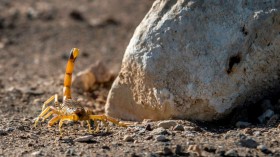For more than a year after the mysterious and early death of Malah, the Milwaukee County Zoo's famed orangutan, animal experts puzzled over what could have killed the great ape at such a young age.
Now, in a paper published in the journal Emerging Infectious Diseases, it has been revealed that a rare species of tapeworm is what caused Malah's death.
Research leader Tony Goldberg of the University of Wisconsin-Madison's School of Veterinary Medicine, said that this tapeworm species was previously unknown to science and should be considered a new threat to primates.
"At the beginning, all we had were Mahal's clinical condition and a tissue sample," said Goldberg, a veterinarian and expert on emerging and rare diseases in humans and other primates. "We knew there was some type of infection in there. It could have been nearly anything. The list of potential agents was enormous."
Mahal died on Dec. 29, 2012 at age 5. Orangutans typically live into their 30s, at least, so the death of the orangutan came as a shock. Zoo experts initially believed that the cause of death was pneumonia, according to the Milwaukee Journal-Sentinel.
A new genetic diagnostic test enabled them to rule out pneumonia as a cause of death, finding instead that a larval tapeworm caused Mahal to contract a deadly infection.
"Larval tapeworms infect the tissues of animals," Goldberg said. "This life stage is different from the adult form, which is the long, wormlike stage we usually think of."
The tapeworm found in Mahal was of an unknown species in the newly categorized Versteria genus, which more often found in rodents.
"It's possible the parasite was expecting to be in a mouse but found itself inside an orangutan," Goldberg said, adding that how and when Mahal remains a mystery.
"For reasons we don't understand, tapeworms sometimes go haywire," Goldberg said. "It is possible he was infected a few weeks before he died. Or he may have been infected several years ago and the tapeworm was dormant and suddenly started to multiply out of control."
Goldberg said the analysis revealed that nothing could have been done to save Mahal.
"This was an unknown species and a very unusual presentation," he said. "On hindsight, there was nothing that could have been done to prevent it by anyone at the zoo or anywhere else, and by the time the infection made Mahal sick it had already gotten out of control. This was an unfortunate quirk with very sad consequences."
© 2024 NatureWorldNews.com All rights reserved. Do not reproduce without permission.

![Bison Herd Consisting of 170 Reintroduced Individuals in Romania Could Store Carbon Emissions Equivalent to 43,000 Cars [Study]](https://1471793142.rsc.cdn77.org/data/thumbs/full/70533/280/157/50/40/bison-herd-consisting-of-170-reintroduced-individuals-in-romania-could-store-carbon-emissions-equivalent-to-43-000-cars-study.jpg)



